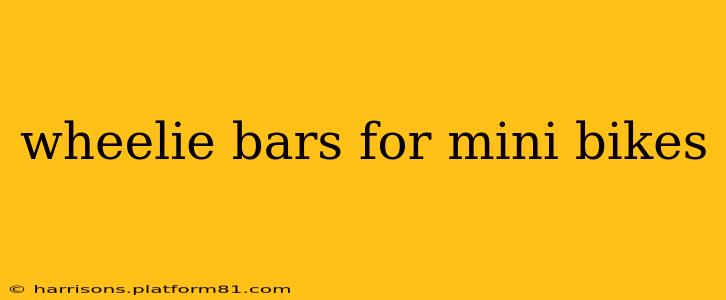Mini bikes, with their compact size and powerful engines, can be exhilarating to ride. However, their lightweight nature can lead to unpredictable wheelies, especially during acceleration. This is where wheelie bars come in. These crucial additions significantly improve control, preventing unwanted wheelies and enhancing overall riding safety and performance. This comprehensive guide will explore everything you need to know about wheelie bars for mini bikes, from their purpose and types to installation and benefits.
What are Wheelie Bars and Why Use Them on a Mini Bike?
Wheelie bars are small, typically adjustable, bars that extend from the rear of a mini bike, making contact with the ground. Their primary function is to prevent the front wheel from lifting off the ground during acceleration or other maneuvers. By providing a counterbalance to the bike's tendency to wheelie, they enhance stability and control, allowing for safer and more consistent performance. They are essential for riders who want to maximize their mini bike's potential without sacrificing control or risking a dangerous crash.
What are the Different Types of Wheelie Bars for Mini Bikes?
Several types of wheelie bars cater to different preferences and mini bike setups. The most common types include:
-
Fixed Wheelie Bars: These are simple, non-adjustable bars that are welded or bolted directly to the frame. They offer a straightforward, cost-effective solution, but lack adjustability.
-
Adjustable Wheelie Bars: These allow you to change the height and angle of the bars to fine-tune the balance of your mini bike, making them ideal for different riding styles and terrains. They often feature threaded rods or other mechanisms for easy adjustment.
-
Swing Arm Mounted Wheelie Bars: Instead of attaching directly to the frame, these bars connect to the swing arm, offering increased flexibility and potentially smoother operation.
Choosing the right type depends on your riding style, budget, and the specific characteristics of your mini bike. Adjustable bars are generally preferred for their versatility.
How to Install Wheelie Bars on a Mini Bike?
Installing wheelie bars varies slightly depending on the type of bars and your mini bike's design. However, the general process typically involves these steps:
-
Measure and Mark: Accurately measure the desired height and position for your wheelie bars on the frame or swing arm. Mark these points clearly.
-
Drill Pilot Holes (if necessary): If your bars require mounting holes, drill pilot holes at the marked positions to guide the screws or bolts.
-
Secure the Wheelie Bars: Use appropriate fasteners (bolts, screws, or welds) to securely attach the wheelie bars to your mini bike. Ensure the attachment is robust to withstand the forces involved in acceleration.
-
Adjust and Test: Adjust the height of your wheelie bars to find the optimal balance, preventing wheelies without significantly hindering acceleration. Test the setup in a safe area to ensure proper functionality and adjust as needed.
Important Note: Always consult your mini bike's manual and utilize appropriate safety equipment during installation and testing.
What are the Benefits of Using Wheelie Bars on a Mini Bike?
The benefits of using wheelie bars extend beyond simple wheelie prevention:
-
Improved Safety: Wheelie bars drastically reduce the risk of accidents caused by uncontrolled wheelies, especially at high speeds.
-
Enhanced Control: They give you much greater control over your mini bike, particularly during acceleration and hard starts.
-
Increased Performance: By preventing wheelies, they help to maximize acceleration and power transfer to the rear wheel.
-
Reduced Tire Wear: Preventing wheelies also reduces wear and tear on your front tire, extending its lifespan.
-
Better Handling: They offer improved overall handling and stability, leading to a more enjoyable riding experience.
Can I Use Wheelie Bars on Different Types of Mini Bikes?
While the specific installation method might vary, wheelie bars can generally be used on a wide range of mini bike types. However, it's crucial to choose bars that are appropriately sized and designed for your mini bike's frame and swing arm. Checking compatibility is essential before purchasing and installing them.
Where Can I Find Wheelie Bars for My Mini Bike?
Wheelie bars for mini bikes can be found at various retailers, both online and in physical stores specializing in mini bikes, parts, and accessories.
What are the potential drawbacks of using wheelie bars on a mini bike?
While the benefits are substantial, potential drawbacks exist:
-
Reduced Top Speed: In some cases, wheelie bars may slightly reduce top speed, depending on their design and adjustment.
-
Increased Drag: The bars create additional drag, although usually minimal.
-
Added Weight: They add a small amount of weight to the mini bike.
These drawbacks are usually insignificant compared to the safety and performance benefits that wheelie bars provide.
This guide provides a comprehensive overview of wheelie bars for mini bikes. By understanding their function, types, installation, and benefits, you can make an informed decision on whether to incorporate them into your mini bike setup, enhancing safety, control, and the overall riding experience. Remember always to prioritize safety and utilize appropriate safety equipment when riding and maintaining your mini bike.
